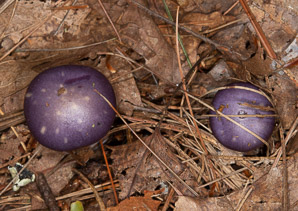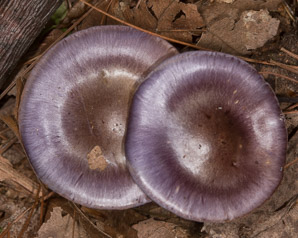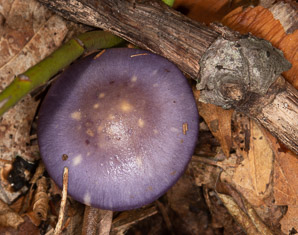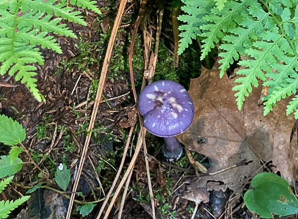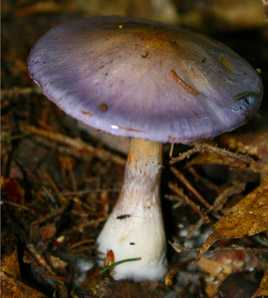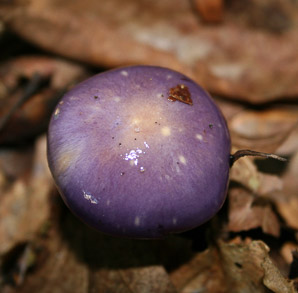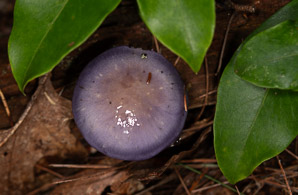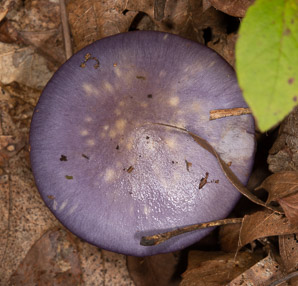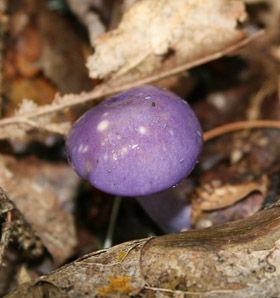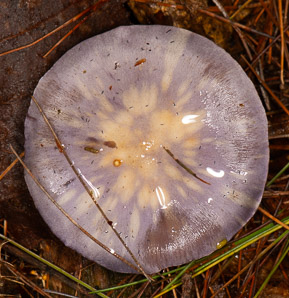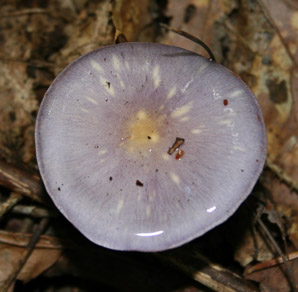
|
Cortinarius iodes (Berkeley & M.A. Curtis) Spotted cort, heliotrope webcap, viscid violet cort
Spotted corts are native to eastern North America. They are found in oak forests because they have a mutually beneficial, mycorrhizal relationship with the roots of oak trees. Stem: 1-2½″ (3-7 cm) long × ⅛-½″ (5-15 mm) thick. Stems are fairly uniform in thickness, but thicker at the base. Stems are mostly white, sometimes with a faint purplish tinge. These mushrooms do not have a special odor. Cap: Caps are 1-2″ (3-6 cm) in diameter, and purple, lilac, or blue in color. As they age, yellowish or brownish spots develop, clustered toward the center of the cap. Both cap and stem are slimy. The color, spots, and sliminess are distinctive features, narrowing the ID to this or Cortinarius iodeoides. Caps are convex, bell-shaped, or domelike in the center. Gills are attached to the stem, pale lavendar in color when young, brownish or grayish when older. Spores: Spore print is rust-colored. If you have a microscope handy, spores are 8–12 × 5–7 µm, and ellipsoid. (The similar-appearing species Cortinarius iodeoides has smaller spores, also ellipsoid, measuring 7-8 × 4-5 µm.) Edibility: These aren’t outright poisonous, but don’t eat them. Online References:
Michael Kuo's MushroomExpert.com 10/6/2018 · Marble Hill Conservation Area, Stow, Massachusetts 8/13/2017 · Burges Pond, Westford, Massachusetts · ≈ 7 × 4½″ (18 × 12 cm) 10/6/2018 · Marble Hill Conservation Area, Stow, Massachusetts 7/23/2021 · University of New Hampshire, Durham, New Hampshire · By Deirdra Baldwin 6/15/2007 · Maine · By Kathleen Williamson
Cortinarius iodes description by Thomas H. Kent, last updated 19 Aug 2023. © FloraFinder.org. All rights reserved. |
6/15/2007 · Maine · By Kathleen Williamson 9/27/2018 · Pearl Hill State Park, Townsend, Massachusetts · ≈ 6 × 4″ (16 × 11 cm) 10/6/2018 · Marble Hill Conservation Area, Stow, Massachusetts 6/15/2007 · Maine · By Kathleen Williamson 9/10/2021 · Crystal Spring Farm, Blueberry Loop, Brunswick, Maine · ≈ 6 × 4″ (15 × 10 cm) 6/15/2007 · Maine · By Kathleen Williamson
|
